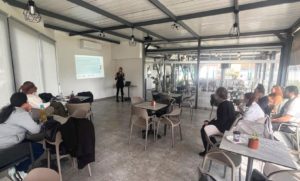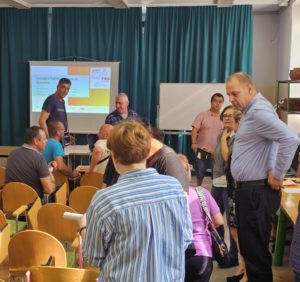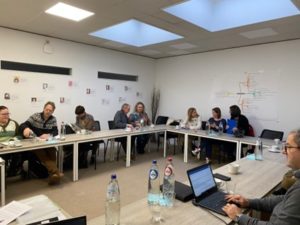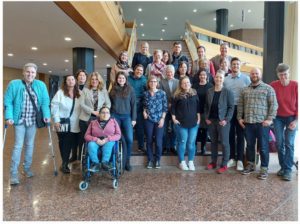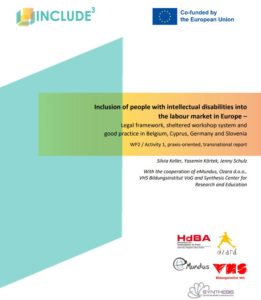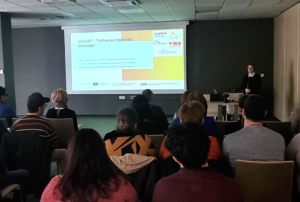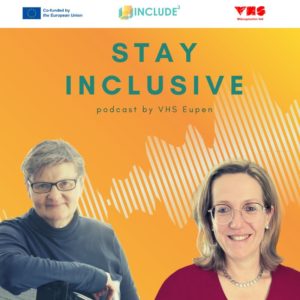Blog
It is important to include people with cognitive disabilities (such as learning difficulties) in the job market. This makes society fairer. Therefore, companies, government agencies, and other key people must work together.
There is a project running to make this happen. It is called Include³. It supports article 27 of the UN Convention on the Rights of Persons with Disabilities, which gives people with disabilities the right to work.
Include3 runs from 2022 to 2025. It is developing a method. The method helps counsellors in sheltered workshops. Counsellors use the method to help with the transition from the workshop to the normal labour market.
There are guidelines in the project. The guidelines say something about counselling, vocational training and networks. The guidelines say how people with disabilities can be well prepared for the labour market. The guidelines for Include³ are developed together with people with disabilities. The opinion of people with disabilities is important for Include³.
The guidelines have three important points: Counselling, vocational training, and networking. With them, we can work out a plan for inclusive workplaces:
- What a good workplace for people with cognitive disabilities looks like.
- Why stress management is important.
- What steps companies and authorities can take.
- A Supportive Workplace is Important
People with cognitive disabilities need a workplace that suits their needs. Companies play a big role in making this happen.
1.1 What an Inclusive Workplace Looks Like
Companies can take different steps:
✅ Adjust work tasks → Adapt tasks so everyone can contribute.
✅ Use helpful tools → For example, special software or simple work processes.
✅ Offer flexible work hours → Allow employees to work in a way that fits their abilities.
✅ Provide mentors → A trusted person can help with questions and problems.
1.2 Educate Other Employees
Other employees should also understand inclusion. Training can help remove misunderstandings:
✅ Communication workshops → Teach employees how to interact respectfully.
✅ Information campaigns → Explain why inclusion is important.
✅ Share success stories → Show examples of companies that have done it well.
- Authorities Must Help
Companies need support to make inclusion work. Important actions include:
✅ Better cooperation → Regular meetings between businesses and authorities.
✅ Inclusion experts in government offices → Specific people to help with inclusion topics.
✅ Financial support → Funding for companies that hire people with disabilities.
- Strengthening Exchange and Cooperation
Sharing experiences helps everyone. Companies can:
✅ Use platforms for exchange → Learn from others.
✅ Improve internal communication → Make it easy to discuss concerns and solutions.
✅ Build networks → Gain more knowledge and support.
- Managing Stress and Creating a Positive Work Environment
4.1 Learning to Handle Stress
Everyone experiences stress differently. Tips for reducing stress:
✅ Identify stress triggers → What makes you feel pressured? Find out.
✅ Practice dealing with challenges → This helps you feel more confident.
✅ Have a support person → Someone to talk to when you feel overwhelmed.
4.2 Building a Strong Team
A good team makes work easier:
✅ Team-building activities → Strengthen relationships through shared experiences.
✅ Use individual strengths → Let people do what they are best at.
✅ Show appreciation → A little praise can boost motivation.
- Making Inclusion Work in the Long Term
For inclusion to be successful, companies should:
✅ Provide training → Prepare employees for working together.
✅ Use videos with real-life examples → Show positive experiences.
✅ Hire additional support staff → Bring in experts to help.
✅ Clearly explain the benefits → Inclusion helps both people and businesses.
The Goal: A Workplace for Everyone with include3
Inclusion is a shared task. Companies, government agencies, employees, and society must work together. By adapting workplaces, raising awareness, and managing stress better, we create long-term improvements for everyone.
The include3 project is an important step further. The Include³ guidelines help people with disabilities to successfully enter the labour market. They are also the basis for a curriculum. We are developing the curriculum in the Include³ project.
Check out our guidelines by using the following link: https://include3.eu/guidelines-for-method-development/

The project’s goal is to find, share, and use successful examples of transitioning from sheltered employment to regular jobs in Europe.
Organizers will collect innovative examples of vocational training, guidance, and transitions, and evaluate them to see what can be applied elsewhere.
These examples will be used to develop a new counseling method called the Include³-method. This method helps counselors in sheltered workshops align the needs of people with cognitive impairments and the job market.
The method will be written down in a curriculum and tested in sheltered workshops. All the project’s findings will be freely available on the Include³ website.



